Classic horse training and behavior modification involve the use of negative reinforcement, which is the application of pressure that is released when your horse moves away from it. This works well because horses naturally move away from pressure. The concern is that if pressure is not released as soon as the horse responds, the horse won't understand that the response was correct. After a while, your horse can become dulled to the cues. Horses like this are often referred to as stubborn. Sometimes the amount of pressure applied is excessive and is perceived as punishment, which can trigger fear.
Recently there has been a movement toward using positive reinforcement training methods for horses. This technique aims to capture the desired behavior and reward it so that the horse learns to repeat it. Positive reinforcement is popular among dog trainers but is also used in zoos and with marine mammals. Positive reinforcement has been shown across species to be a very effective strategy for training new behaviors. Animals with a history of positive reinforcement training are more likely to try new things, and to be better and more willing learners.
Positive reinforcement can be used to train simple groundwork such as standing to be groomed, tacked and mounted, coming when called, or picking up feet. It can also be used to create positive emotional experiences with otherwise fearful stimuli such as a trailer. Positive reinforcement can be used under saddle as well, particularly with the use of a marker word.
Step One
- Choose a marker. This can be a clicker, though a clicker is less practical for use in the saddle. It can be a whistle held in your mouth, a click of the tongue, or a word, like “yes” or “good”.
- As a rule, the marker should be as distinctive as possible. A tongue click is not a good idea if you use this noise for other purposes (to mean “go forward”).
- Teach your horse that the marker means food is coming. Mark and give a treat several times in a row until your horse can be seen to look for the treat when they hear the marker.
Step Two
- Teach your horse to nose target. You can use your hand or a target stick. Hold the target close and when your horse sniffs at it, mark and treat. Keep it easy at first. When your horse seems to understand what’s going on, you can add a word like “touch”. Next start to hold the target to the side, up higher, down lower, a few steps in front, etc.
- The target becomes something familiar and trustworthy. If your horse touches it, food is coming.
Ringlet, paint mare touching target#1.jpg
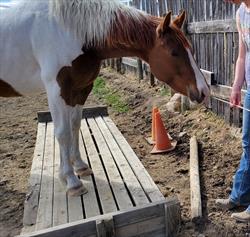
Ringlet, a 3-year-old paint mare, touches her nose to the target. All Photos Courtesy of the Author
Step Three
- The target can be used to teach your horse to load on a trailer, come when called, walk over a tarp/water/pole, etc., even a jump or to go through a barrel pattern.
- You can also teach your horse to target with different parts of their body such as a foot which is useful for the farrier, or a shoulder which is useful for things like opening and closing gates from the saddle or teaching pivots and spins.
Ringlet, jumping to touch target#2.jpg
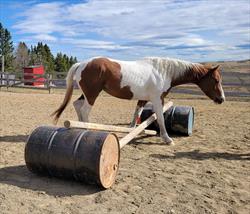
Ringlet goes over a jump for the first time to touch the target stick (just barely visible to the right of the picture). All Photos Courtesy of the Author
Positive Reinforcement Training from the Saddle
Purely positive reinforcement training during riding is difficult to accomplish. Since most of our cues with horses involve touch and pressure from legs, hands, and seats, there is an inherent part of negative reinforcement training that comes with riding. Especially in those disciplines where verbal cues are not allowed in the show ring.
Certain specific tasks can be accomplished with a helper and a target stick such as walking over, under, or through obstacles or helping to teach specific patterns. Your horse will then associate the learning of these exercises with something rewarding.
In general, cues are taught by gently applying the signal. When your horse responds, remove the signal, and mark the behavior. In the beginning, rewards should come consistently with each performance of the behavior. Over time, you can vary the number of repetitions between treats.
Ringlet turns head to right #3.jpg
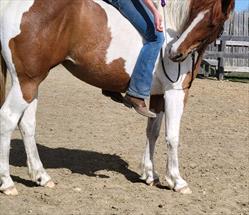
Teaching a turn on the haunches: Ringlet turns her head to the right and gets a treat. All Photos Courtesy of the Author
Ringlet starts to move#4.jpg
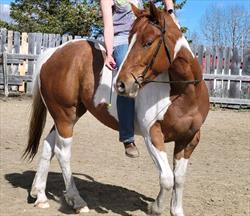
Ringlet starts to move, turning toward the target stick. All Photos Courtesy of the Author
Ringlet moves on the forehand #5.jpg
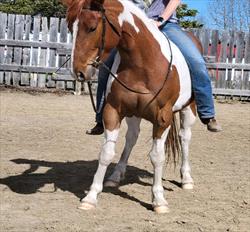
Movement continues. Hind feet stay nearly in the same place while front end moves around. There is no contact with Ringlet's sides or mouth, she is not being pulled or pushed into the turn. As she starts to get the idea, touch and release with rider's left heel in front of the girth area will be added to signal for the turn. Over time Ringlet will be asked for more precise placement of the hind feet for the reward. All Photos Courtesy of the Author
Many horse owners don’t like using food to train their horses. Sometimes this stems from owners who believe the horse should listen to cues out of respect or because they have been previously trained, and their owners feel the horse should know how to behave.
Instead, positive reinforcement training should be considered a method of developing a partnership between you and your horse. Some horses may have dietary restrictions due to a medical condition such as laminitis or Cushings, or perhaps the owners are concerned about obesity. Food rewards need not be large or rich in sugars or calories but for most horses, food is the best and most convenient reward. If food absolutely cannot be used, a scratch on the withers area may be the next best thing.